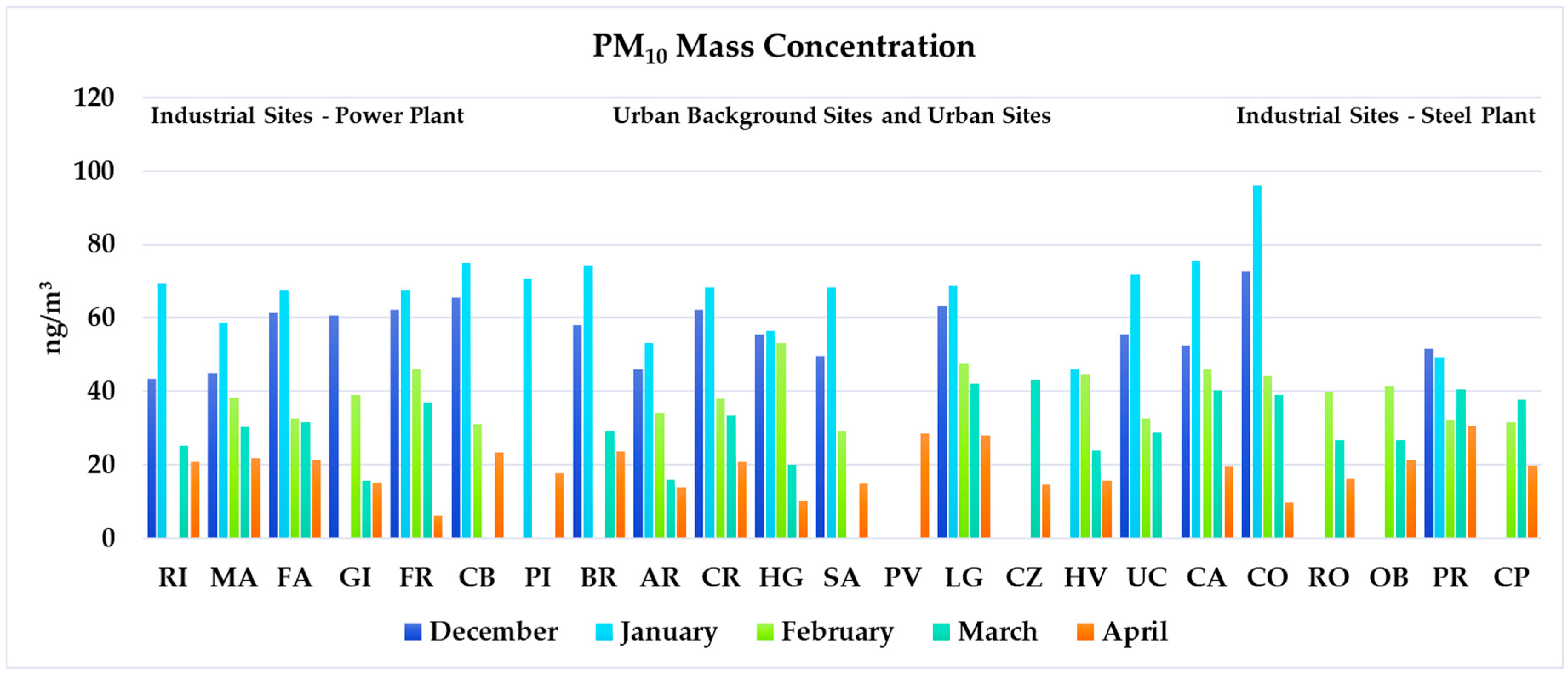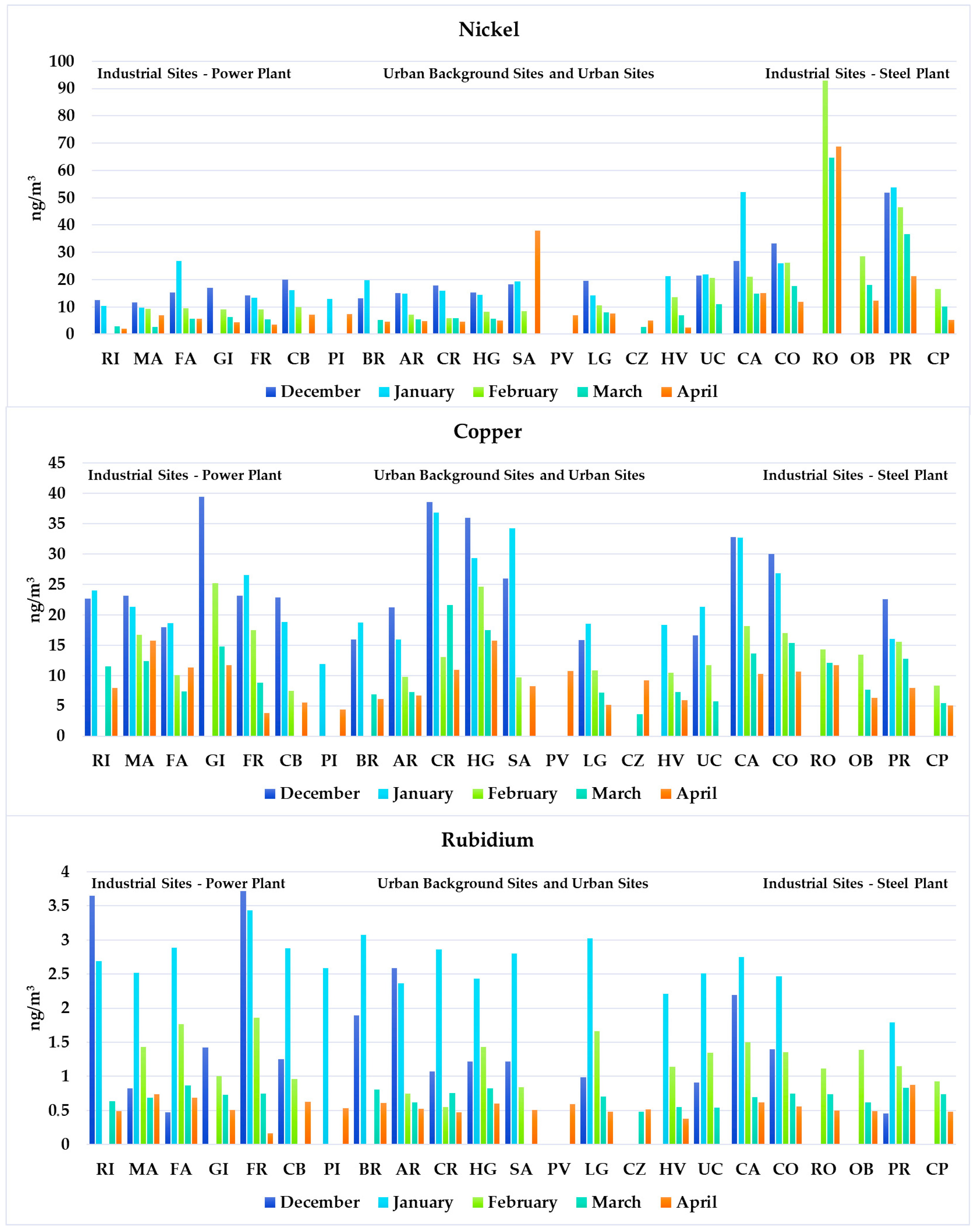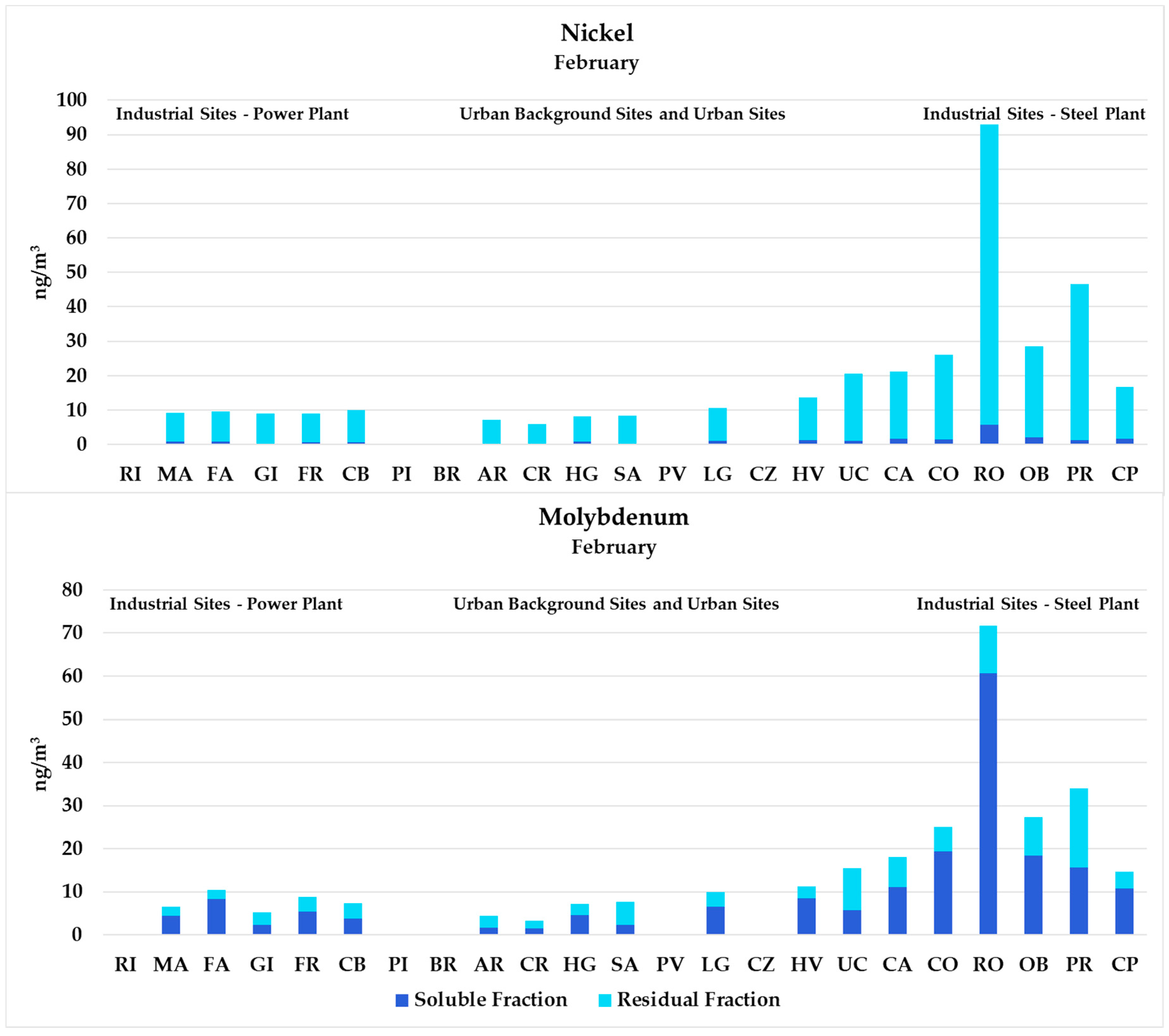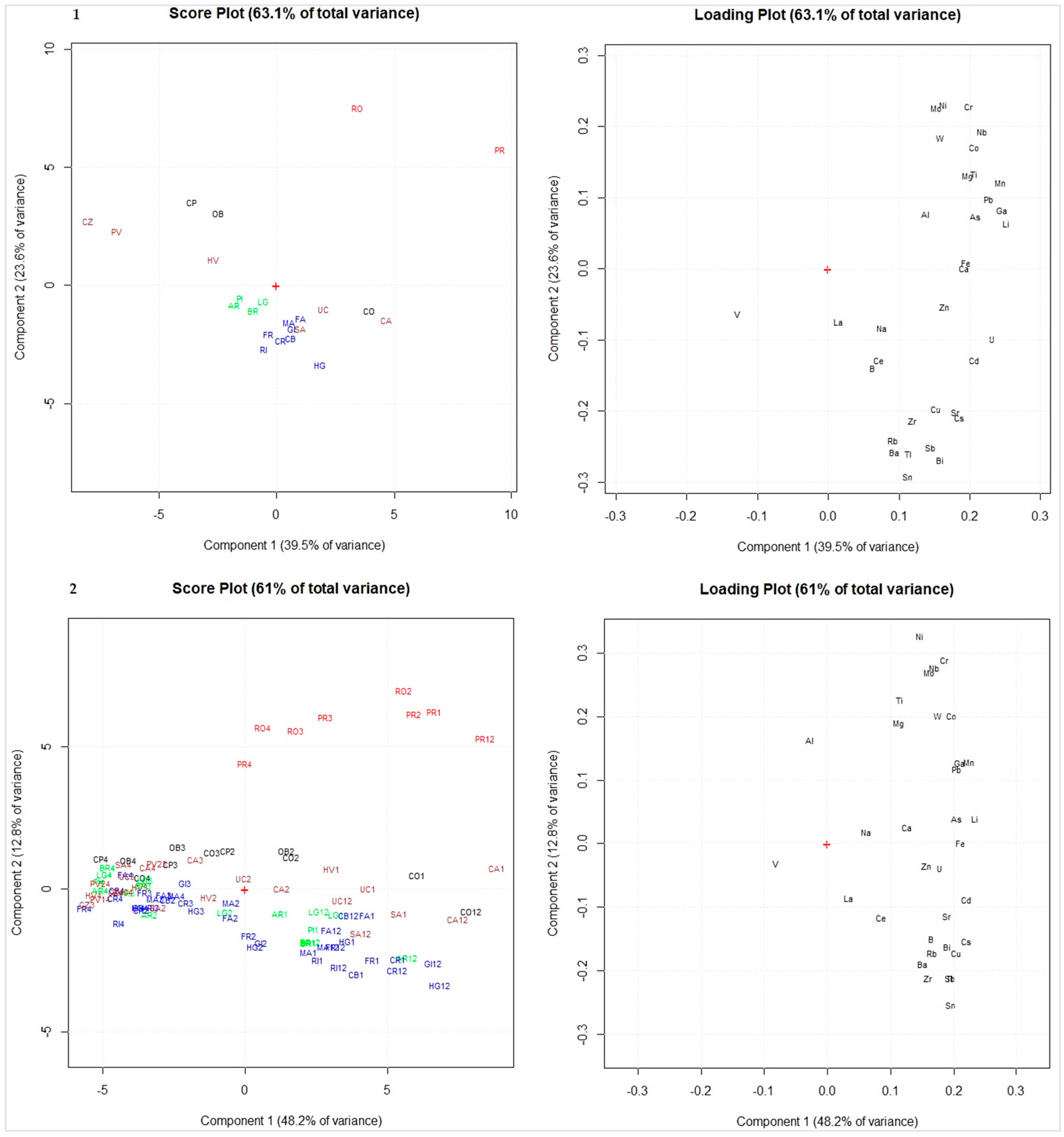Monitoring and Evaluation of Terni (Central Italy) Air Quality through Spatially Resolved Analyses
Abstract
:1. Introduction
2. Experiments
2.1. Sampling Sites and Sampling Equipment
- -
- power plant for waste treatment located in the West of the city;
- -
- railway;
- -
- vehicular traffic due to the presence of streets with heavy traffic;
- -
- domestic biomass heating;
- -
- very extensive steel plant in the East of the city.
2.2. Analytical Procedure
2.3. Statistical Analysis
2.4. Element Solubility Percentages
3. Results and Discussion
3.1. PM10 Mass Concentration
3.2. Elemental Concentration
3.2.1. Ni, Cr, Mn, Mo, Pb and Fe Concentration
3.2.2. Cu and Sb Concentration
3.2.3. Rb, Bi, Sr, Mg and V Concentration
3.3. Source Tracers Identification by Principal Component Analysis
- -
- the urban background sites, located in the South and in the North of the city, outside the high density urban areas, (BR, AR, PI and LG) are represented with the green color;
- -
- the sites situated in the West of the city, in the industrial area near the power plant for waste treatment where domestic biomass heating systems are used (MA, RI, GI, FR, CR, HG, FA and CB) are represented with the blue color;
- -
- the sites located in the East of the city, in proximity of the steel plant (OB and CP) or between the steel plant and the city center (CO) are represented with the black color;
- -
- the sites located in the East of the city, close to the steel plant (RO and PR) are represented with the red color;
- -
- the urban sites, situated in high density urban areas and/or near heavy traffic streets (CZ, HV, SA, UC, CA and PV) are represented with the brown color.
3.4. Seasonal Variability of Element Solubility Percentages in PM10
4. Conclusions
Supplementary Materials
Acknowledgments
Author Contributions
Conflicts of Interest
References
- Pope, C.A.; Burnett, R.T.; Thun, M.J.; Calle, E.E.; Krewski, D.; Ito, K.; Thurston, G.D. Lung Cancer Cardiopulmonary Mortality, and Long-term Exposure to Fine Particulate Air Pollution. J. Am. Med. Assoc. 2002, 287, 1132–1141. [Google Scholar] [CrossRef]
- Hwang, I.; Hopke, P.K. Estimation of Source Apportionment and Potential Source Locations of PM2.5 at a West Coastal IMPROVE Site. Atmos. Environ. 2007, 4, 506–518. [Google Scholar] [CrossRef]
- Conti, G.O.; Heibati, B.; Kloog, I.; Fiore, M.; Ferrante, M. A review of AirQ Models and their applications for forecasting the air pollution health outcomes. Environ. Sci. Pollut. Res. 2017, 24, 6426–6445. [Google Scholar] [CrossRef] [PubMed]
- Vitali, L.; Morabito, A.; Adani, M.; Assennato, G.; Ciancarella, L.; Cremona, G.; Giua, R.; Pastore, T.; Piersanti, A.; Righini, G.; et al. A Lagrangian modelling approach to assess the representativeness area of an industrial air quality monitoring station. Atmos. Pollut. Res. 2016, 7, 990–1003. [Google Scholar] [CrossRef]
- Weil, J.C.; Sykes, R.I.; Venkatram, A. Evaluating air quality models: Review and Outlook. J. Appl. Meteorol. 1992, 31, 1121–1145. [Google Scholar] [CrossRef]
- Irwin, J.C. A suggested method for dispersion model evaluation. J. Air Waste Manag. Assoc. 2014, 4, 255–264. [Google Scholar] [CrossRef]
- Padoan, E.; Malandrino, M.; Giacomino, A.; Grosa, M.M.; Lollobrigida, F.; Martini, S.; Abollino, O. Spatial distribution and potential sources of trace elements in PM10 monitored in urban and rural sites of Piedmont Region. Chemosphere 2016, 145, 495–507. [Google Scholar] [CrossRef] [PubMed]
- Kim, B.U.; Bae, C.; Kim, H.C.; Kim, E.; Kim, S. Spatially and chemically resolved source apportionment analysis: Case study of high particulate matter event. Atmos. Environ. 2017, 162, 55–70. [Google Scholar] [CrossRef]
- Fox, D.G. Uncertainty in Air Quality Modeling. Bull. Am. Meteorol. Soc. 1984, 65, 27–36. [Google Scholar] [CrossRef]
- Almeida, S.M.; Pio, C.A.; Freitas, M.C.; Reis, M.A.; Trancoso, M.A. Source apportionment of atmospheric urban aerosol based on weekdays/weekend variability: Evaluation of road re-suspended dust contribution. Atmos. Environ. 2006, 40, 2058–2067. [Google Scholar] [CrossRef]
- Perrino, C.; Canepari, S.; Pappalardo, S.; Marconi, E. Time-resolved measurements of water-soluble ions and elements in atmospheric particulate matter for the characterization of local and long-range transport events. Chemosphere 2010, 80, 1291–1300. [Google Scholar] [CrossRef] [PubMed]
- Moroni, B.; Ferrero, L.; Crocchianti, S.; Cappelletti, D. Aerosol dynamics upon Terni basin (Central Italy): Results of integrated vertical profile measurements and electron microscopy analysis. Rendiconti Lincei 2013, 24, 319–328. [Google Scholar] [CrossRef]
- Guerrini, R. Qualità dell’aria nella provincia di Terni tra il 2002 e il 2011. Quad. ARPA Umbria 2012, XXXIII, 81–87. [Google Scholar] [CrossRef]
- Canepari, S.; Pietrodangelo, A.; Perrino, C.; Astolfi, M.L.; Marzo, M.L. Enhancement of source traceability of atmospheric PM by elemental chemical fractionation. Atmos. Environ. 2009, 43, 4754–4765. [Google Scholar] [CrossRef]
- Canepari, S.; Cardarelli, E.; Giuliano, A.; Pietrodangelo, A. Determination of metals, metalloids and non-volatile ions in airborne particulate matter by a new two-step sequential leaching procedure Part A: Experimental design and optimization. Talanta 2006, 69, 581–587. [Google Scholar] [CrossRef] [PubMed]
- Canepari, S.; Cardarelli, E.; Giuliano, A.; Strincone, M. Determination of metals, metalloids and non-volatile ions in airborne particulate matter by a new two-step sequential leaching procedure Part B: Validation on equivalent real samples. Talanta 2006, 69, 588–595. [Google Scholar] [CrossRef] [PubMed]
- Templeton, D.M.; Ariese, F.; Cornelis, R.; Danielsson, L.G.; Muntau, H.; Van Leeuwen, H.P.; Lobinski, R. Guidelines for terms related to chemical speciation and fractionation of elements. Definitions, structural aspects, and methodological approaches (IUPAC Recommendations 2000). Pure Appl. Chem. 2000, 72, 1453–1470. [Google Scholar] [CrossRef]
- Canepari, S.; Astolfi, M.L.; Farao, C.; Maretto, M.; Frasca, D.; Marcoccia, M.; Perrino, C. Seasonal variations in the chemical composition of particulate matter: A case study in the Po Valley. Part II: Concentration and solubility of micro- and trace-elements. Environ. Sci. Pollut. R. 2014, 21, 4010–4022. [Google Scholar] [CrossRef] [PubMed]
- Perrino, C.; Catrambone, M.; Dalla Torre, S.; Rantica, E.; Sargolini, T.; Canepari, S. Seasonal variations in the chemical composition of particulate matter: A case study in the Po Valley. Part I: Macro-components and mass closure. Environ. Sci. Pollut. Res. 2014, 21, 3999–4009. [Google Scholar] [CrossRef] [PubMed]
- Harrison, R.M.; Yin, J. Particulate matter in the atmosphere: Which particle properties are important for its effects on health? Sci. Total Environ. 2000, 249, 85–101. [Google Scholar] [CrossRef]
- Perrino, C.; Tofful, L.; Canepari, S. Chemical characterization of indoor and outdoor fine particulate matter in an occupied apartment in Rome, Italy. Indoor Air 2016, 26, 558–570. [Google Scholar] [CrossRef] [PubMed]
- Blair, M.; Stevens, T.L. Steel Castings Handbook, 6th ed.; Steel Founders’ Society and ASM International: Novelty, OH, USA, 1995; pp. 2–34. [Google Scholar]
- Li, R.; Wiedinmyer, C.; Hannigan, M.P. Contrast and correlations between coarse and fine particulate matter in the United States. Sci. Total Environ. 2013, 456–457, 346–358. [Google Scholar] [CrossRef] [PubMed]
- Taiwo, A.M.; Harrison, R.M.; Shi, Z. A review of receptor modelling of industrially emitted particulate matter. Atmos. Environ. 2014, 97, 109–120. [Google Scholar] [CrossRef]






| Type of Site & Major Local PM Emission Sources | Geographical Coordinates | ||
|---|---|---|---|
| Latitude | Longitude | ||
| RI | Industrial Site-Power Plant & Biomass Domestic Heating | 42°33′52.02″ N | 12°35′21.94″ E |
| MA | Industrial Site-Power Plant | 42°33′41.42″ N | 12°36′19.05″ E |
| FA | Industrial Site-Power Plant | 42°33′03.19″ N | 12°36′29.76″ E |
| GI | Industrial Site-Power Plant & Railway | 42°34′06.28″ N | 12°36′48.27″ E |
| FR | Industrial Site-Power Plant & Biomass Domestic Heating | 42°33′53.22″ N | 12°37′11.44″ E |
| CB | Industrial Site-Power Plant | 42°33′20.30″ N | 12°37′20.45″ E |
| PI | Urban Background Site (South of the City) | 42°32′56.96″ N | 12°37′52.26″ E |
| BR | Urban Background Site (North of the City) | 42°34′56.19″ N | 12°37′23.30″ E |
| AR | Urban Background Site (North of the City) | 42°34′34.23″ N | 12°37′39.88″ E |
| CR | Industrial Site-Power Plant & Railway | 42°34′09.49″ N | 12°37′39.81″ E |
| HG | Urban Site-Vehicular Traffic & Railway | 42°34′19.32″ N | 12°37′56.02″ E |
| SA | Urban Site-Heavy Vehicular Traffic | 42°33′45.16″ N | 12°38′18.45″ E |
| PV | Urban Site-Vehicular Traffic | 42°33′06.96″ N | 12°38′35.20″ E |
| LG | Urban Background Site (South of the City) | 42°32′59.75″ N | 12°39′01.16″ E |
| CZ | Urban Site-Vehicular Traffic | 42°34′06.90″ N | 12°38′52.97″ E |
| HV | Urban Site-Vehicular Traffic | 42°33′58.33″ N | 12°39′04.74″ E |
| UC | Urban Site-Vehicular Traffic | 42°33′38.09″ N | 12°38′47.62″ E |
| CA | Urban Site-Heavy Vehicular Traffic | 42°33′39.01″ N | 12°39′03.11″ E |
| CO | Industrial Site-Steel Plant & Heavy Vehicular Traffic | 42°33′34.23″ N | 12°39′22.62″ E |
| RO | Industrial Site-Steel Plant | 42°33′51.16″ N | 12°39′39.15″ E |
| OB | Industrial Site-Steel Plant | 42°34′18.64″ N | 12°40′05.57″ E |
| PR | Industrial Site-Steel Plant | 42°34′20.30″ N | 12°40′44.23″ E |
| CP | Industrial Site-Steel Plant | 42°33′31.65″ N | 12°40′36.04″ E |
| Month | December | January | February | March | April | ||||||||||
|---|---|---|---|---|---|---|---|---|---|---|---|---|---|---|---|
| AM | ± | SD | AM | ± | SD | AM | ± | SD | AM | ± | SD | AM | ± | SD | |
| Li | 65 | ± | 6 | 68 | ± | 5 | 57 | ± | 13 | 34 | ± | 9 | 68 | ± | 16 |
| B | 51 | ± | 14 | 79 | ± | 9 | 67 | ± | 19 | 53 | ± | 29 | 70 | ± | 22 |
| Na | 39 | ± | 17 | 44 | ± | 27 | 53 | ± | 10 | 55 | ± | 15 | 49 | ± | 11 |
| Mg | 51 | ± | 6 | 57 | ± | 10 | 47 | ± | 9 | 37 | ± | 6 | 54 | ± | 9 |
| Al | 9 | ± | 3 | 9 | ± | 3 | 5 | ± | 2 | 1 | ± | 1 | 3 | ± | 1 |
| Ca | 47 | ± | 17 | 64 | ± | 13 | 50 | ± | 15 | 26 | ± | 11 | 57 | ± | 15 |
| Ti | 1 | ± | 0 | 3 | ± | 2 | 4 | ± | 2 | 1 | ± | 0 | 4 | ± | 2 |
| V | 32 | ± | 14 | 51 | ± | 27 | 51 | ± | 25 | 45 | ± | 18 | 75 | ± | 11 |
| Cr | 6 | ± | 2 | 6 | ± | 3 | 4 | ± | 2 | 3 | ± | 2 | 9 | ± | 4 |
| Mn | 45 | ± | 5 | 47 | ± | 5 | 38 | ± | 9 | 26 | ± | 9 | 45 | ± | 8 |
| Fe | 3 | ± | 2 | 3 | ± | 2 | 3 | ± | 2 | 1 | ± | 0 | 4 | ± | 1 |
| Co | 15 | ± | 4 | 20 | ± | 15 | 14 | ± | 6 | 10 | ± | 6 | 23 | ± | 13 |
| Ni | 10 | ± | 5 | 9 | ± | 3 | 7 | ± | 3 | 5 | ± | 3 | 15 | ± | 8 |
| Cu | 22 | ± | 5 | 22 | ± | 4 | 23 | ± | 7 | 12 | ± | 7 | 32 | ± | 7 |
| Zn | 47 | ± | 14 | 54 | ± | 12 | 43 | ± | 11 | 13 | ± | 7 | 37 | ± | 12 |
| Ga | 11 | ± | 3 | 14 | ± | 3 | 13 | ± | 6 | 5 | ± | 3 | 32 | ± | 20 |
| As | 59 | ± | 12 | 65 | ± | 8 | 51 | ± | 21 | 15 | ± | 9 | 87 | ± | 8 |
| Rb | 67 | ± | 21 | 90 | ± | 1 | 86 | ± | 8 | 52 | ± | 7 | 70 | ± | 14 |
| Sr | 48 | ± | 12 | 74 | ± | 10 | 65 | ± | 16 | 45 | ± | 11 | 75 | ± | 10 |
| Zr | 1 | ± | 1 | 1 | ± | 1 | 5 | ± | 3 | 1 | ± | 1 | 6 | ± | 7 |
| Nb | 1 | ± | 1 | 1 | ± | 1 | 4 | ± | 2 | 1 | ± | 1 | 39 | ± | 21 |
| Mo | 43 | ± | 7 | 60 | ± | 10 | 60 | ± | 16 | 63 | ± | 9 | 82 | ± | 7 |
| Cd | 89 | ± | 9 | 70 | ± | 13 | 71 | ± | 18 | 38 | ± | 20 | 93 | ± | 5 |
| Sn | 1 | ± | 0 | 2 | ± | 1 | 7 | ± | 4 | 4 | ± | 2 | 15 | ± | 6 |
| Sb | 26 | ± | 5 | 35 | ± | 9 | 27 | ± | 12 | 29 | ± | 10 | 53 | ± | 12 |
| Cs | 77 | ± | 4 | 81 | ± | 2 | 66 | ± | 9 | 31 | ± | 7 | 95 | ± | 5 |
| Ba | 29 | ± | 9 | 42 | ± | 10 | 28 | ± | 0 | 28 | ± | 0 | 47 | ± | 15 |
| La | 7 | ± | 4 | 8 | ± | 6 | 12 | ± | 8 | 3 | ± | 2 | 6 | ± | 4 |
| Ce | 4 | ± | 2 | 4 | ± | 3 | 11 | ± | 8 | 3 | ± | 1 | 3 | ± | 5 |
| W | 37 | ± | 6 | 47 | ± | 6 | 42 | ± | 13 | 43 | ± | 15 | 70 | ± | 20 |
| Tl | 81 | ± | 5 | 77 | ± | 5 | 69 | ± | 13 | 49 | ± | 10 | 95 | ± | 20 |
| Pb | 19 | ± | 4 | 12 | ± | 3 | 15 | ± | 5 | 6 | ± | 4 | 20 | ± | 6 |
| Bi | 3 | ± | 1 | 6 | ± | 1 | 8 | ± | 4 | 5 | ± | 3 | 28 | ± | 29 |
| U | 11 | ± | 2 | 7 | ± | 4 | 15 | ± | 7 | 9 | ± | 6 | 88 | ± | 0 |
© 2017 by the authors. Licensee MDPI, Basel, Switzerland. This article is an open access article distributed under the terms and conditions of the Creative Commons Attribution (CC BY) license (http://creativecommons.org/licenses/by/4.0/).
Share and Cite
Massimi, L.; Ristorini, M.; Eusebio, M.; Florendo, D.; Adeyemo, A.; Brugnoli, D.; Canepari, S. Monitoring and Evaluation of Terni (Central Italy) Air Quality through Spatially Resolved Analyses. Atmosphere 2017, 8, 200. https://doi.org/10.3390/atmos8100200
Massimi L, Ristorini M, Eusebio M, Florendo D, Adeyemo A, Brugnoli D, Canepari S. Monitoring and Evaluation of Terni (Central Italy) Air Quality through Spatially Resolved Analyses. Atmosphere. 2017; 8(10):200. https://doi.org/10.3390/atmos8100200
Chicago/Turabian StyleMassimi, Lorenzo, Martina Ristorini, Marta Eusebio, Darla Florendo, Adeola Adeyemo, Davide Brugnoli, and Silvia Canepari. 2017. "Monitoring and Evaluation of Terni (Central Italy) Air Quality through Spatially Resolved Analyses" Atmosphere 8, no. 10: 200. https://doi.org/10.3390/atmos8100200





